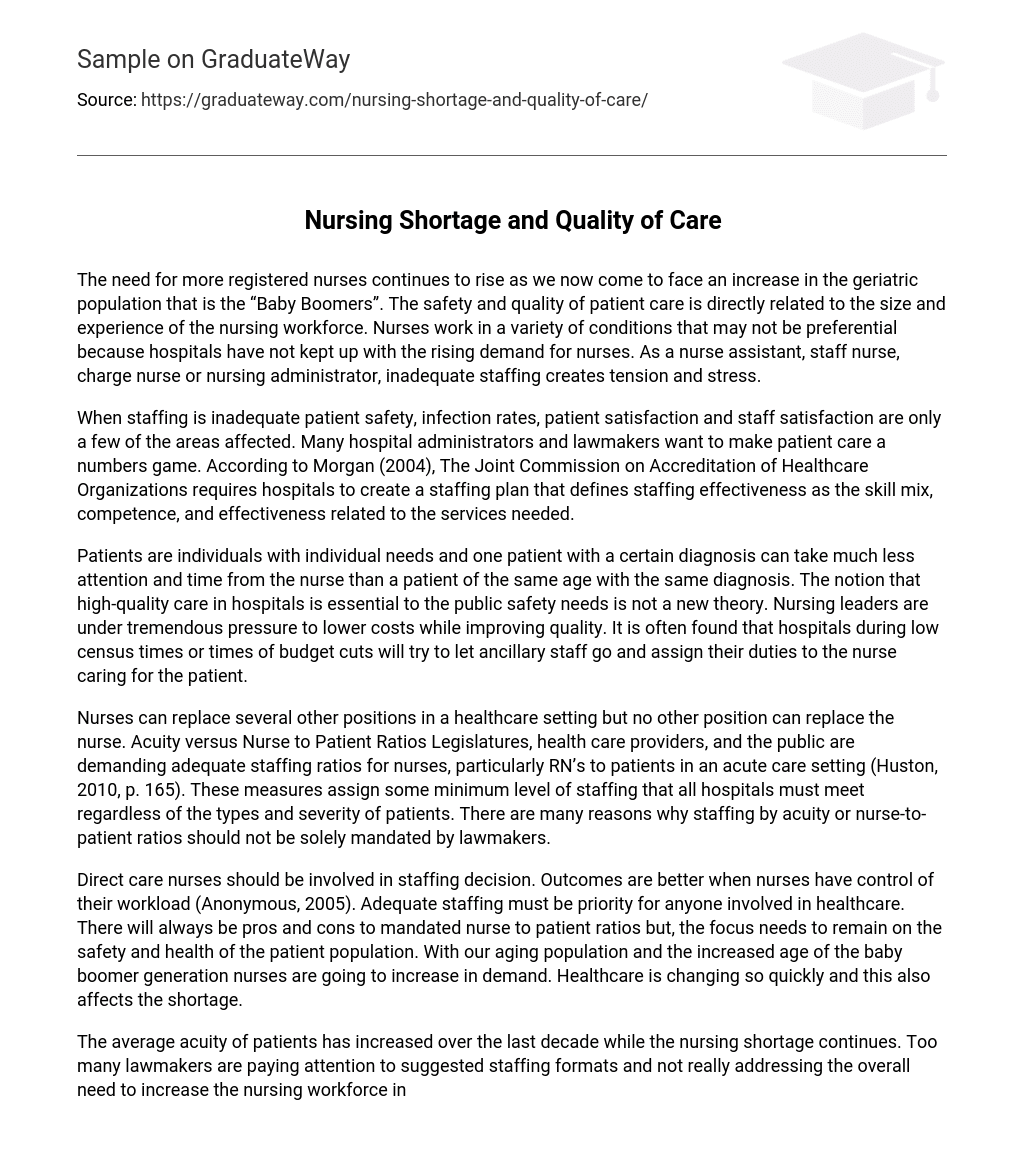With the increasing geriatric population of “Baby Boomers,” there is an elevated requirement for additional registered nurses. The nursing workforce’s size and expertise have a direct impact on the safety and quality of patient care. Unfortunately, hospitals have been unable to meet the rising demand for nurses, resulting in nurses working under unfavorable conditions. Inadequate staffing creates tension and stress among nurse assistants, staff nurses, charge nurses, and nursing administrators.
Insufficient staffing has negative effects on multiple areas, such as patient safety, infection rates, patient satisfaction, and staff satisfaction. Hospital administrators and lawmakers are increasingly seeing patient care as a quantitative measure. According to Morgan (2004), The Joint Commission on Accreditation of Healthcare Organizations requires hospitals to develop a staffing plan that considers the necessary skill mix, competency levels, and effectiveness for the services provided.
Patients with varying diagnoses and ages may have different levels of attention and time required from nurses. The significance of delivering excellent care in hospitals for public safety has long been acknowledged. Nursing leaders grapple with the dilemma of balancing cost reduction and quality enhancement. In certain situations, hospitals may opt to assign extra responsibilities to nurses instead of utilizing ancillary staff as a means to cut costs during periods of low patient numbers or budget constraints.
The significance of nurses in healthcare is irreplaceable, resulting in a greater emphasis on nurse-to-patient ratios in acute care environments. Legislatures, healthcare providers, and the public are advocating for suitable levels of staffing, specifically for registered nurses (RNs). These ratios consider patient acuity and set minimum staffing mandates for all hospitals. However, depending solely on legislated staffing determined by acuity or nurse-to-patient ratios may not be the ultimate solution due to multiple factors.
It is important for direct care nurses to participate in staffing decisions as it leads to improved outcomes when they have control over their workload (Anonymous, 2005). Ensuring sufficient staffing should be a top priority for all healthcare professionals. Although mandated nurse to patient ratios come with pros and cons, the primary focus should always be on the safety and well-being of patients. The aging population, combined with the growing number of baby boomers reaching old age, will create a greater need for nurses. Additionally, the rapid transformations occurring in healthcare further contribute to the shortage.
In recent years, the average acuity of patients has increased, yet there remains a shortage of nurses. Rather than addressing the fundamental need for more nurses to ensure safe and effective healthcare, many lawmakers concentrate on proposed staffing formats. Regardless of whether we consider acuity or ratios, it is necessary to have more nurses available so that each nurse can care for fewer patients. Staffing based on patient acuity involves determining the required number of nursing hours based on specific diagnoses or types of patients.
In healthcare facilities, nurses often care for multiple patients at once in less critical areas. This is because the acuity score of these patients is lower compared to those in intensive care or step-down units. Healthcare systems that base staffing on acuity aim to determine a safe patient load for nurses at various levels. However, some worry that administration may manipulate these numbers to maintain a high nurse-to-patient ratio.
Although Acuity is not comprehensive in patient encounters, it may not consider certain factors. For example, a dementia patient’s acuity might be low in terms of nursing care because they usually don’t have indwelling lines or invasive procedures. However, this same patient may need significant support with daily activities, decision making, and education. Therefore, staffing based on acuity can be a subjective approach to nurse staffing. In California, nurse-to-patient ratios are required to determine the number of patients assigned to each nurse.
California state guidelines dictate that the nurse-to-patient ratios in acute care facilities are determined by the specific types of patients being treated. The legislation mandating these ratios was approved in 1999, but it took four years for it to be put into effect. In the case of medical-surgical patients, one nurse is assigned to five patients, whereas in intensive care units, one nurse attends to a single patient. However, California has encountered various challenges concerning these ratios, such as extended transfer durations for patients, heightened instances of emergency room bypassing, and delayed elective surgeries.
California has seen 12 hospitals close or reduce services due to the implementation of ratios. Patients have unique needs and nursing units vary, so ratios do not consider factors such as nurse experience or unit layout. In my opinion, patient-to-nurse ratios can be helpful in reducing accidents, staff burnout, and job dissatisfaction. Additionally, ratios can also improve the overall quality of care for patients.
Considering the advantages and disadvantages of ratios, I believe a more proactive approach would involve incorporating both the acuity level and the actual patient census when determining staffing for a unit or facility. Facilities that solely rely on an improvised method of acuity for staffing assignments may result in overwhelmed nurses. Conversely, failing to take acuity into account increases the risk of complications, accidents, and lower mortality rates for patients. This legislation has been adopted in various states and countries.
Some legislatures have implemented laws to establish hospital-wide nursing care committees that recommend staffing plans based on patient care needs (Huston, 2010, p. 173). In addition, certain states require annual evaluations of these plans. It is crucial for all states to consider the impact on nurses and patients, as their satisfaction directly affects the efficiency of the healthcare system and ultimately benefits all patients.





